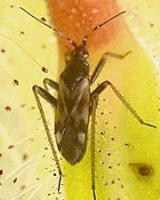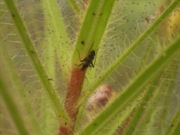
Pameridea
Encyclopedia
Pameridea is a genus
of insect
s comprising two species.
Roridula
. There are two Roridula
species: Roridula gorgonias and Roridula dentata. Pameridea marlothii only occurs on R. dentata, while P. roridulae exists on both.
Roridula feeding on insects that the plant captures with its resin
-tipped trichome
s. After devouring the captured arthropod
s, it then proceeds to excrete waste, which the plant absorbs using glands. It is therefore a symbiotic insect
because of this. It mates, too, while on the plant, and hatchlings continue to live on the Roridula plant.
enthusiasts.
 The relationship with Roridula consists primarily of the fact that Roridula produces resin that cannot digest the bugs like other carnivorous plants such as Dionaea muscipula, or Drosera, Pinguicula
The relationship with Roridula consists primarily of the fact that Roridula produces resin that cannot digest the bugs like other carnivorous plants such as Dionaea muscipula, or Drosera, Pinguicula
, Nepenthes
and other carnivorous plants have. Thus, P. roridulae and P. marlothii devour the trapped insects on the Roridula and then excrete waste which is consumeable by the plant to supplement its carnivory since it grows in nutrient poor soil. Without the Roridula the Pameridea cannot find a food source; and ultimately die. They breed and live on the plant. Because P. roridulae and P. marlothii eat and digest the food for the plant, some carnivorous plant
enthusiasts consider Roridula only sub-carnivorous; however it is only a matter of style. Even though Sarracenia purpurea
uses a variety of worm to digest captured arthropods for them, and the same is true for Darlingtonia californica
, Roridula is related in these ways. Pameridea have special feet with hairs on them that allow them to run through the plants' resin without being caught themselves.
Genus
In biology, a genus is a low-level taxonomic rank used in the biological classification of living and fossil organisms, which is an example of definition by genus and differentia...
of insect
Insect
Insects are a class of living creatures within the arthropods that have a chitinous exoskeleton, a three-part body , three pairs of jointed legs, compound eyes, and two antennae...
s comprising two species.
Symbiosis
Pameridea roridulae lives in a symbiotic relationship with the carnivorous plantCarnivorous plant
Carnivorous plants are plants that derive some or most of their nutrients from trapping and consuming animals or protozoans, typically insects and other arthropods. Carnivorous plants appear adapted to grow in places where the soil is thin or poor in nutrients, especially nitrogen, such as acidic...
Roridula
Roridula
Roridula is a South African genus of plants that, whilst having many of the adaptations of a carnivorous plant, such as the possession of insect-trapping sticky hairs, does not directly digest the animals it traps. Instead, it has a mutualistic relationship with Pameridea roridulae, a species of...
. There are two Roridula
Roridula
Roridula is a South African genus of plants that, whilst having many of the adaptations of a carnivorous plant, such as the possession of insect-trapping sticky hairs, does not directly digest the animals it traps. Instead, it has a mutualistic relationship with Pameridea roridulae, a species of...
species: Roridula gorgonias and Roridula dentata. Pameridea marlothii only occurs on R. dentata, while P. roridulae exists on both.
Life cycle
Pameridea roridulae can only live on the plantPlant
Plants are living organisms belonging to the kingdom Plantae. Precise definitions of the kingdom vary, but as the term is used here, plants include familiar organisms such as trees, flowers, herbs, bushes, grasses, vines, ferns, mosses, and green algae. The group is also called green plants or...
Roridula feeding on insects that the plant captures with its resin
Resin
Resin in the most specific use of the term is a hydrocarbon secretion of many plants, particularly coniferous trees. Resins are valued for their chemical properties and associated uses, such as the production of varnishes, adhesives, and food glazing agents; as an important source of raw materials...
-tipped trichome
Trichome
Trichomes are fine outgrowths or appendages on plants and certain protists. These are of diverse structure and function. Examples are hairs, glandular hairs, scales, and papillae.- Algal trichomes :...
s. After devouring the captured arthropod
Arthropod
An arthropod is an invertebrate animal having an exoskeleton , a segmented body, and jointed appendages. Arthropods are members of the phylum Arthropoda , and include the insects, arachnids, crustaceans, and others...
s, it then proceeds to excrete waste, which the plant absorbs using glands. It is therefore a symbiotic insect
Insect
Insects are a class of living creatures within the arthropods that have a chitinous exoskeleton, a three-part body , three pairs of jointed legs, compound eyes, and two antennae...
because of this. It mates, too, while on the plant, and hatchlings continue to live on the Roridula plant.
Conservation status
Since it is symbiotic with the Roridula plant, its status depends on the status of the plant. The Roridula plant is scarce in the wild, due to collecting, pollution, and habitat destruction, although it is secure in cultivation from avid carnivorous plantCarnivorous plant
Carnivorous plants are plants that derive some or most of their nutrients from trapping and consuming animals or protozoans, typically insects and other arthropods. Carnivorous plants appear adapted to grow in places where the soil is thin or poor in nutrients, especially nitrogen, such as acidic...
enthusiasts.
Characteristics
Pameridea roridulae and P. marlothii both have wings; however they are not very good fliers. They are small bugs, usually not reaching more than a few millimetres in size.Relationship with Roridula

Pinguicula
The butterworts are a group of carnivorous plants comprising the genus Pinguicula. Members of this genus use sticky, glandular leaves to lure, trap, and digest insects in order to supplement the poor mineral nutrition they obtain from the environments. Of the roughly 80 currently known species, 12...
, Nepenthes
Nepenthes
The Nepenthes , popularly known as tropical pitcher plants or monkey cups, are a genus of carnivorous plants in the monotypic family Nepenthaceae. The genus comprises roughly 130 species, numerous natural and many cultivated hybrids...
and other carnivorous plants have. Thus, P. roridulae and P. marlothii devour the trapped insects on the Roridula and then excrete waste which is consumeable by the plant to supplement its carnivory since it grows in nutrient poor soil. Without the Roridula the Pameridea cannot find a food source; and ultimately die. They breed and live on the plant. Because P. roridulae and P. marlothii eat and digest the food for the plant, some carnivorous plant
Carnivorous plant
Carnivorous plants are plants that derive some or most of their nutrients from trapping and consuming animals or protozoans, typically insects and other arthropods. Carnivorous plants appear adapted to grow in places where the soil is thin or poor in nutrients, especially nitrogen, such as acidic...
enthusiasts consider Roridula only sub-carnivorous; however it is only a matter of style. Even though Sarracenia purpurea
Sarracenia purpurea
Sarracenia purpurea, commonly known as the purple pitcher plant, northern pitcher plant, or side-saddle flower, is a carnivorous plant in the family Sarraceniaceae...
uses a variety of worm to digest captured arthropods for them, and the same is true for Darlingtonia californica
Darlingtonia californica
Darlingtonia californica , also called the California Pitcher plant, Cobra Lily, or Cobra Plant, is a carnivorous plant, the sole member of the genus Darlingtonia in the family Sarraceniaceae. It is native to Northern California and Oregon, growing in bogs and seeps with cold running water...
, Roridula is related in these ways. Pameridea have special feet with hairs on them that allow them to run through the plants' resin without being caught themselves.

